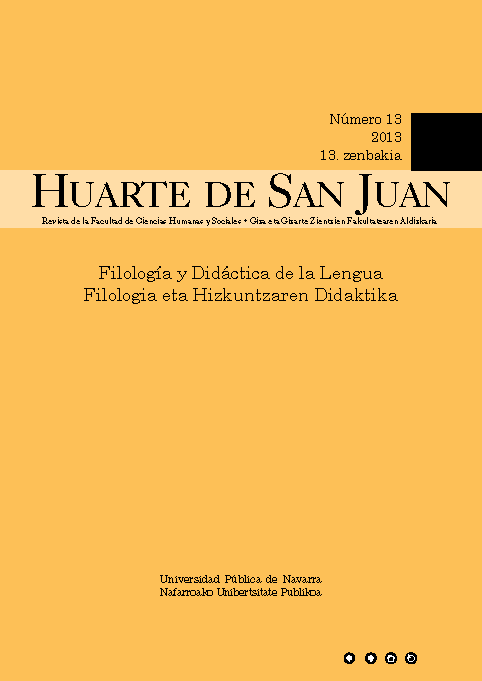El monólogo de humor Un proyecto de educación literaria
Keywords:
Spectacular paradigm, humor, interdisciplinary nature, teaching sequenceAbstract
The aim of this article is to show a proposal for literary education focused on the «stand-up» comedy, framed in the drama genre and the «spectacular paradigm ». In these pages, I suggest a teaching sequence whose final output is writing and dramatizing a monologue individually. The main objective is to approach literature to students by providing them successful experiences and to work with humor as a transverse element for educational mediation. Moreover, a reflection about the essence of drama by the students is intended and the development of their creativity and linguistic expression, plastic and artistic body is expected as well.
Downloads
References
Boal, A. (1992): Games for actors and non-actors, Routledge, Río de Janeiro.
Camps, A. (comp.) (2003): Secuencias didácticas para aprender a escribir, Graó, Barcelona.
Colomer, T. (1991): «De la enseñanza de la literatura», en Teoría literaria y enseñanza de la lengua, Cátedra, Madrid, pp. 317-341.
García Larrauri, B. (2006): Programa para mejorar el sentido del humor, Pirámide, Madrid.
Helbo, A. (1989) Teoría del espectáculo. El paradigma espectacular, Galerna/Lemcke, Argentina.
Kowzan, T. (1969): «El signo en el teatro. Introducción a la semiología del teatro», en AA.VV., El teatro y su crisis actual, Monte Ávila Editores, Venezuela.
Lavandier, Y. (2003): La dramaturgia, Eiunsa.
Lomas, C. (1996): La enseñanza lingüística y literaria en la educación secundaria, Horsori, Barcelona.
Margallo, A. M. (2011): «La educación literaria como eje de la programación», en Camps, A. y Ruiz Bikandi, U. (coords.), Didáctica de la lengua castellana y la literatura, Graó, Barcelona, pp. 167-187.
Mendoza Fillola, A. (2008): La educación literaria: bases para la formación de la competencia lecto-literaria, Biblioteca Virtual Miguel de Cervantes, Alicante. [(2004), Málaga, Ediciones Aljibe].
Motos, T. y Tejedo, F. (2007): Prácticas de dramatización, Ñaque. Ciudad Real.
Pavis, P. (1980): Diccionario del teatro. Dramaturgia, estética, semiología, Paidós, Barcelona.
Ruiz, T., Apraiz, M. y Pérez, M. (2011): «Las competencias básicas y la materia de lengua castellana y literatura», Textos de didáctica de la lengua y la literatura, 56: 53-65.
Vilà i Santasusana, M. (coord.) (2008): El discurso oral formal. Contenidos de aprendizaje y secuencias didácticas, Graó, Barcelona.
Enlaces web
Aranguren, I.; Galbete, V.; Goyache, M.ª J. y Pascual, M.ª T. (1996): Blabla. Dramatización. Materias optativas, Gobierno de Navarra: <http://dpto.educacion.navarra.es/publicaciones/pdf/drama_dg.pdf>.
Calatrava Valles, J.R. (2004): «Del papel a las tablas: el proceso transductivo de Cinco horas con Mario de Delibes (Novela, versiones, representaciones teatrales)», en Revista literaria, vol. 66, nº 132: 485-502: <http://revistadeliteratura.revistas.csic.es/index.php/revistadeliteratura/article/view/130/141>.
Canal de literatura IJ: sol <http://www.canallector.com/>
Castellón A. H. (2008): Los monólogos. Algunas notas para su análisis, IPFA Almería – UNED Lorca: <http://www.lllf.uam.es/clg8/actas/pdf/paperCLG23.pdf>.
García Barrientos, J. L. (2004): «Teatro y narratividad», en Revista Arbor (CSIC): 509-524: <http://arbor.revistas.csic.es/index.php/arbor/article/view/592/594>.
Downloads
Published
How to Cite
Issue
Section
License
All articles are published under a Creative Commons (BY-NC-ND 4.0) license. Each article will be assigned a DOI.
Authors retain copyright of their work and grant the journal the right to the first publication. Authors can sign additional agreements to non-exclusive distribution of the published version of the article (for example, in an institutional repository) as long as appropriate attribution to the original publication is provided. Articles can be uploaded to institutional repositories immediately after publication.
Electronic distribution of the articles (for example, academic social networks or personal webpages) is allowed and encouraged.
The journal reserves the right to publicise the work in social networks and other electronic means.







